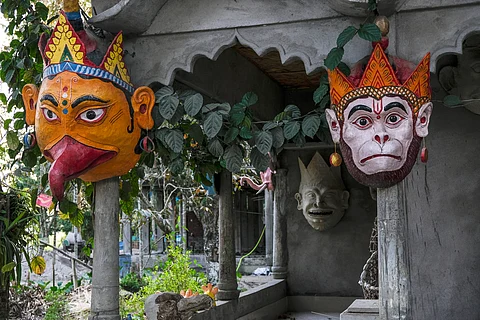
- Destinations
- Experiences
- Stay
- What's new
- Celebrating People
- Responsible Tourism
- CampaignsCampaigns
- SubscribeSubscribe
- Buy Now

Majuli is a unique riverine delta located on the Brahmaputra River in Assam. It has been formed due to the dynamics of the vast river system and is primarily rural, home to over 240 villages with a rich mix of tribes and communities. The island is renowned for being the seat of the neo-Vaishnavite culture of Assam and houses many satras or monasteries. These ancient satras celebrate the tradition of art, folk culture and heritage of the Ahom kingdom, with each reflecting a distinct identity and serving as a sanctorum to a different art form. Some of these masks have been exhibited in museums abroad, such as the Victoria & Albert Museum in London. Recently, the traditional art forms of Mukha Xilpo was awarded the prestigious Geographical Indication (GI) tag.
Srimanta Sankaradeva, a Vaishnavite saint from the 15th-16th century, was the driving force behind the promotion of Neo-Vaishnavism philosophy in Majuli. He introduced the use of mukha in the theatrical performance of Bhaona to effectively convey various expressions of mythological characters. The masks are created using natural forms. There are two types of masks: loukik (worldly) and oloukik (otherworldly, supernatural). The striking oloukik masks represent characters with exaggerated features, including the 100-hooded Kaliya Nag and a Brahma with four faces. The masks can be categorised into the following types.
Actors wear these masks only on their faces while covering the rest of their bodies with colorful cloth during performances.
These masks cover most of the actor. The head of the mask is referred to as "mukha", and the body is called "su". Therfore, it is also known as "su-mukha". The "bor mukha" can be around ten feet tall. The size of the masks reflects the grandeur of the characters they represent, such as Ravana, Narasimha, Narakasura, and Kumbhakarna.
Unlike bor mukhas, the heads of these masks are not tied to the bodies. Instead, they consist of separate elements that allow for greater mobility. Used to portray demons such as Taraka, Shankhasura, and Bakasura, they are more commonly seen during the famous Rasa Lila festival of Majuli, than during Bhaonas.
